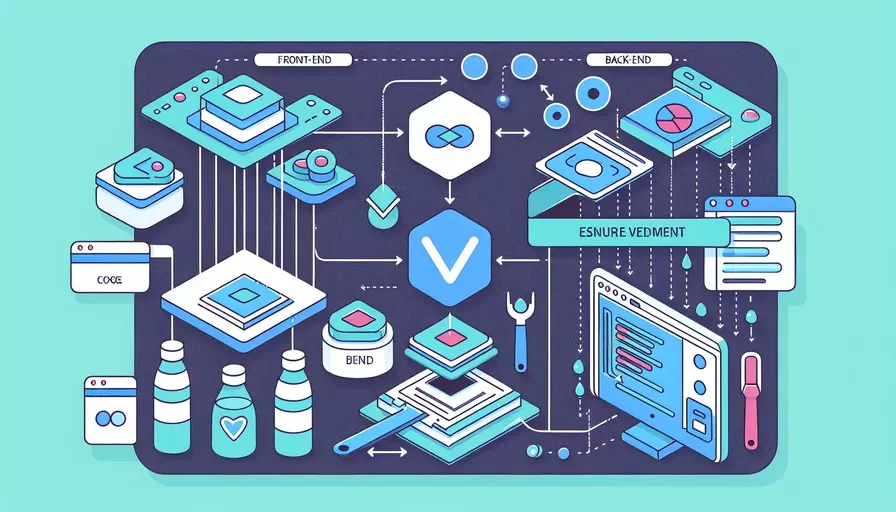
前后端分离调接口的关键在于以下几点:1、配置代理解决跨域问题,2、使用Axios进行HTTP请求,3、在Vue组件中调用接口并处理返回数据。
其中,配置代理解决跨域问题是最重要的一步。由于前后端分离的架构中,前端项目和后端服务通常运行在不同的服务器上,因此会遇到跨域问题。通过在Vue项目的配置文件中设置代理,可以将前端请求代理到后端服务,从而避免跨域问题。
一、配置代理解决跨域问题
在Vue项目中,可以通过修改vue.config.js文件来配置代理:
module.exports = {
devServer: {
proxy: {
'/api': {
target: 'http://your-backend-server.com',
changeOrigin: true,
pathRewrite: {
'^/api': ''
}
}
}
}
};
以上配置会将所有以/api开头的请求代理到http://your-backend-server.com,并且在请求路径中删除/api前缀。这样,前端就可以通过/api访问后端接口,而不必担心跨域问题。
二、使用Axios进行HTTP请求
安装Axios库:
npm install axios
在Vue项目中,引入Axios并进行全局配置:
import axios from 'axios';
axios.defaults.baseURL = '/api';
axios.defaults.headers.common['Authorization'] = AUTH_TOKEN;
axios.defaults.headers.post['Content-Type'] = 'application/json';
可以在Vue组件中使用Axios进行HTTP请求:
export default {
name: 'ExampleComponent',
data() {
return {
items: []
};
},
created() {
this.fetchData();
},
methods: {
fetchData() {
axios.get('/items')
.then(response => {
this.items = response.data;
})
.catch(error => {
console.error('There was an error fetching the data!', error);
});
}
}
};
三、在Vue组件中调用接口并处理返回数据
在Vue组件中,可以在生命周期钩子函数中调用接口,并将返回的数据存储在组件的状态中。例如,在created钩子函数中调用接口:
export default {
name: 'ExampleComponent',
data() {
return {
items: []
};
},
created() {
this.fetchData();
},
methods: {
fetchData() {
axios.get('/items')
.then(response => {
this.items = response.data;
})
.catch(error => {
console.error('There was an error fetching the data!', error);
});
}
}
};
在模板中,可以通过绑定数据来显示接口返回的数据:
<template>
<div>
<ul>
<li v-for="item in items" :key="item.id">{{ item.name }}</li>
</ul>
</div>
</template>
四、处理接口返回的错误信息
在处理HTTP请求时,除了处理成功的返回结果,还需要处理可能的错误情况。可以在catch方法中处理错误信息,并在页面上显示友好的提示信息:
export default {
name: 'ExampleComponent',
data() {
return {
items: [],
error: null
};
},
created() {
this.fetchData();
},
methods: {
fetchData() {
axios.get('/items')
.then(response => {
this.items = response.data;
})
.catch(error => {
this.error = 'There was an error fetching the data!';
console.error(error);
});
}
}
};
在模板中,可以通过绑定错误信息来显示提示:
<template>
<div>
<ul v-if="!error">
<li v-for="item in items" :key="item.id">{{ item.name }}</li>
</ul>
<div v-else>{{ error }}</div>
</div>
</template>
五、使用Vuex管理全局状态
在大型项目中,可能需要在不同组件之间共享数据。可以使用Vuex来管理全局状态,并在Vuex中调用接口,将返回的数据存储在Vuex的state中:
import Vue from 'vue';
import Vuex from 'vuex';
import axios from 'axios';
Vue.use(Vuex);
const store = new Vuex.Store({
state: {
items: []
},
mutations: {
setItems(state, items) {
state.items = items;
}
},
actions: {
fetchItems({ commit }) {
axios.get('/items')
.then(response => {
commit('setItems', response.data);
})
.catch(error => {
console.error('There was an error fetching the data!', error);
});
}
}
});
export default store;
在组件中,可以通过Vuex的mapState和mapActions辅助函数来访问和修改全局状态:
import { mapState, mapActions } from 'vuex';
export default {
name: 'ExampleComponent',
computed: {
...mapState(['items'])
},
created() {
this.fetchItems();
},
methods: {
...mapActions(['fetchItems'])
}
};
六、使用拦截器统一处理请求和响应
可以使用Axios的请求和响应拦截器,统一处理请求前的配置和响应后的处理,例如添加全局的请求头和错误处理:
axios.interceptors.request.use(config => {
// 在发送请求之前做些什么
config.headers.Authorization = 'Bearer ' + store.state.token;
return config;
}, error => {
// 对请求错误做些什么
return Promise.reject(error);
});
axios.interceptors.response.use(response => {
// 对响应数据做点什么
return response;
}, error => {
// 对响应错误做点什么
if (error.response.status === 401) {
// 未授权,重定向到登录页
router.push('/login');
}
return Promise.reject(error);
});
七、总结
前后端分离调接口的关键在于1、配置代理解决跨域问题,2、使用Axios进行HTTP请求,3、在Vue组件中调用接口并处理返回数据。通过配置代理解决跨域问题,可以避免跨域问题;通过使用Axios进行HTTP请求,可以方便地发送和处理HTTP请求;通过在Vue组件中调用接口并处理返回数据,可以将数据绑定到组件的状态中,并在模板中显示。为了提高代码的可维护性和可复用性,还可以使用Vuex管理全局状态,并使用拦截器统一处理请求和响应。希望本文能够帮助您更好地理解和应用前后端分离调接口的方法。
相关问答FAQs:
1. 什么是前后端分离?
前后端分离是一种软件架构模式,它将前端和后端的开发过程分离开来。前端负责展示界面和用户交互,后端负责处理业务逻辑和数据存储。两者通过接口进行通信。
2. 如何调用后端接口?
在Vue前后端分离的项目中,可以使用Axios库来发送HTTP请求调用后端接口。Axios是一个基于Promise的HTTP客户端,可以在浏览器和Node.js中使用。
首先,你需要在项目中安装Axios。可以通过npm或者yarn安装Axios。
在你的Vue组件中,可以使用以下代码来发送一个GET请求调用后端接口:
import axios from 'axios';
export default {
data() {
return {
responseData: null
};
},
mounted() {
axios.get('http://your-backend-api-url')
.then(response => {
this.responseData = response.data;
})
.catch(error => {
console.error(error);
});
}
}
以上代码在组件的mounted钩子函数中发送一个GET请求,并将后端返回的数据保存在responseData变量中。
如果需要发送POST请求,可以使用以下代码:
axios.post('http://your-backend-api-url', {
data: {
// 请求参数
}
})
.then(response => {
// 处理响应
})
.catch(error => {
console.error(error);
});
3. 如何处理后端接口返回的数据?
在前后端分离的项目中,后端接口通常返回JSON格式的数据。你可以在Vue组件中使用v-for指令来遍历接口返回的数据,并在模板中展示。
以下是一个简单的例子:
<template>
<div>
<ul>
<li v-for="item in responseData" :key="item.id">
{{ item.name }}
</li>
</ul>
</div>
</template>
<script>
import axios from 'axios';
export default {
data() {
return {
responseData: []
};
},
mounted() {
axios.get('http://your-backend-api-url')
.then(response => {
this.responseData = response.data;
})
.catch(error => {
console.error(error);
});
}
}
</script>
在上面的例子中,通过v-for指令遍历responseData数组,并在模板中展示每个元素的name属性。
你也可以根据后端返回的数据进行条件渲染,比如根据某个属性的值来判断是否显示某个元素。
总之,在前后端分离的项目中,调用后端接口并处理返回的数据通常是使用Axios库来实现的。可以根据具体的业务需求,在Vue组件中使用Axios发送HTTP请求,并根据接口返回的数据来更新页面。
文章标题:vue前后端分离如何调接口,发布者:不及物动词,转载请注明出处:https://worktile.com/kb/p/3680556

 微信扫一扫
微信扫一扫  支付宝扫一扫
支付宝扫一扫 